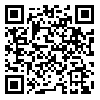BibTeX | RIS | EndNote | Medlars | ProCite | Reference Manager | RefWorks
Send citation to:
URL: http://ijhe.tums.ac.ir/article-1-5288-en.html
2- MSc. in Environmental Sciences Research Institute, Shahid Beheshti University, G.C., Tehran, Iran
3- Expert in Environmental health, Emam Khomeini hospital, Karaj, Iran
Background and Objectives: Although amount of hospital waste generation is less than urban waste generation, but because of health risks involved, these wastes need to be managed precisely and specifically. Therefore, the purpose of this study was to survey quality and quantity of waste generation in Emam Khomaini Hospital, Karaj, Iran and to estimate its generation process in future. Materials and Methods: the total amount of different waste percentage and its weight were examined and analyzed through monthly sampling from segregated waste (including general, infectious, pharmaceutical, and sharp wastes) in Emam Khomaini Hospital in Karaj during four years (2010-2013). Results: the hospital waste generation rate became double during four years of study. Among different types of waste, the highest monthly averages per bed for general and infectious waste was 48.3 and 46.5% respectively. In addition, the most and least amount of waste generation was observed in April and September respectively. Analysis of variance showed that the increasing trend of waste generation had a significant difference (P<0.001). Moreover, the estimate of waste generation process through ARIMA time series model represented continuation of increasing trend of waste generation up to 6.3 (kg bed-1 day-1) on December 2014. Conclusion: Waste generation in Emam Khomaini’s hospital follows an increase trend ( average generation from 2.98 to 4.44 kg bed-1 day-1 in 2010 to 2012 respectively, reflecting the increasing trend in the waste generation. ARIMA time series model shows that the waste generation rate would be 1.5 fold more in autumn 2014. Estimate of waste generation is necessary for planning and designing of waste management.
Received: 2014/08/4 | Accepted: 2015/07/28 | Published: 2015/07/28
| Rights and Permissions | |
 |
This work is licensed under a Creative Commons Attribution-NonCommercial 4.0 International License. |





